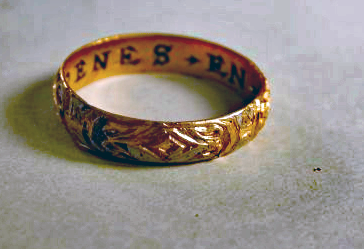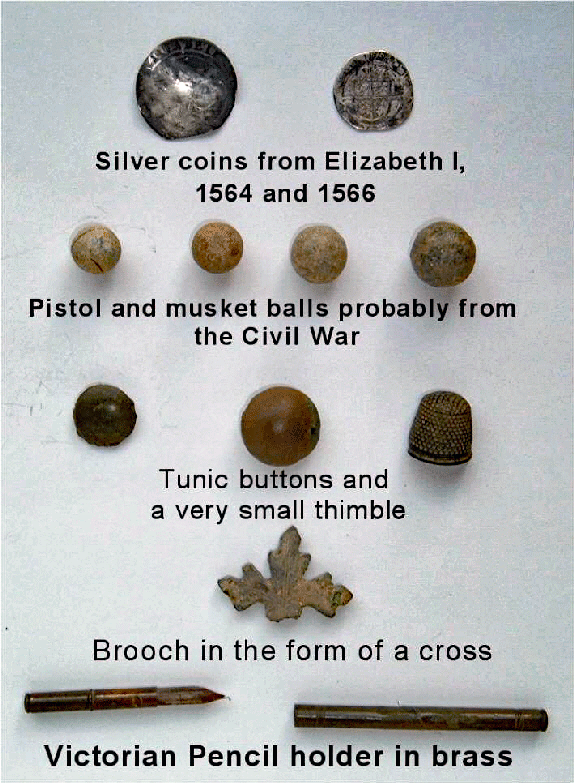Lynsted Church of Saints Peter and Paul - Miscellaneous Features and Discoveries
- Lynsted Medieaval Ring - found somewhere in the Parish.
- Church Footpath finds.
1) The Story of the Lynsted Medieaval Ring
[Society Note: Logged on this page, but the location of the find has not actually been identified for obvious reasons. All we know is that the ring was found in the Parish]
This letter is published with thanks to Phil Talbot of the Historical Research Group of Sittingbourne.
 "A medieval finger-ring, iconographic in type, representing on its double-faceted bezel the images of St Catherine (left) and a bearded male saint (right), possibly St John the Baptist Five beaded lozenges decorate the hoop with two beaded half-lozenges on each shoulder of the ring. The three centrally placed lozenges on the reverse of the hoop contain floral motifs; the remaining two contain what appears to be a heart. The shoulder, half-lozenges contain floral motifs. The finger-ring dates from the fifteenth or early sixteenth century. I can confirm that it contains a minimum of 10% gold" - J P Robinson BM (actually it's near 24 carat!)
"A medieval finger-ring, iconographic in type, representing on its double-faceted bezel the images of St Catherine (left) and a bearded male saint (right), possibly St John the Baptist Five beaded lozenges decorate the hoop with two beaded half-lozenges on each shoulder of the ring. The three centrally placed lozenges on the reverse of the hoop contain floral motifs; the remaining two contain what appears to be a heart. The shoulder, half-lozenges contain floral motifs. The finger-ring dates from the fifteenth or early sixteenth century. I can confirm that it contains a minimum of 10% gold" - J P Robinson BM (actually it's near 24 carat!)
The story regarding the finding of The Lynsted Ring is as follows:
The local club, the Swale Metal Detecting Club, who meet in Sittingbourne at present were offered access to the land on a Sunday morning and approximately 15 members turned up. We were allowed to detect on a large area of grass which had been ploughed up and seeded in the previous year. We spent about 4 hours there and it was about 2 hours into the search that David Villanueva, the Vice Chairman, found what has now become known as The Lynsted Ring. I have known David for many years and we also worked at the same company for most of these. He is a very committed historian and a stickler for doing things 'right'.
David seems to have an uncanny knack of finding the best coins and artefacts if there is anything to be found. I often look over towards him when we are out and on this day he very quietly beckoned me over. Holding a clenched fist over my open palm he dropped what felt like a tractor nut into my hand. To be only the second person to see the ring in its full glory after its loss all those centuries ago was amazing and I was struck dumb for a minute or so. After saying how lucky he was and making other references to his birth status and parentage, I left him to seek the owner and explain the position regarding its legal position and The Treasure Act 1997.
As this was an artefact of gold it immediately came within the Treasure Act 1997 and had to be declared to the coroner for an inquest to be held to establish if it was treasure or not.
The ring was subsequently sent to the British Museum in London and they established that it was gold and what its provenance was, which I stated in the original article.
Items of Treasure are valued by an independent committee called the Treasure Valuation Committee (TVC), which comprises members of national museums, numismatists, antiques professionals etc and two Executive Members of the National Council for Metal Detecting (NCMD).
Within the current system once a value has been decided upon by the committee, the coroner contacts the landowner to establish if the finder did in fact have permission to detect on his land. If it is established that this is not the case then the finder loses all rights to any reward and it all goes to the landowner. Obviously under these circumstances legal proceedings can also be initiated against the original finder for theft.
If the finder did indeed have permission an equal split of the reward is normally the case unless a previously established arrangement has been made between the two of them.
The landowner and finder agreed in this case to split the reward 50/50 which is generally the accepted basis of the Land Search Agreement that the NCMD encourages its members to sign with the landowner at the outset of any detecting arrangement. Obviously the percentage split is negotiable.
During this period museums can apply to purchase the item and this is what generates the reward monies.
Canterbury Museum applied to purchase the ring and were successful. It is now on display in their Treasure exhibition at the museum as I'm led to believe by David. I'm sure your members would love to see the original ring.
That is the full story of the find and as previously stated, David Villanueva has no problem with his name being linked to the find or that of the local club. I know you will understand if I say again that I cannot divulge where it was found without the landowners permission as this would be a serious breach of confidence.
The club also operates a free recovery service for personal items, farm implements, pipes etc to anyone who requests it and are more than happy to help out.
We are also very happy to accept access to search pieces of land should the offer be made to us.
If I can help in any way in the future please contact me and I will endeavour to do what I can to assist.
Regards
Phil Talbot
Lynsted Church Finds - Path Excavations
During the excavation for the new footway, a number of small artefacts were discovered. The picture has been provided by David Wood, who tells us - "The pencil holder was found outside the south porch door, the buttons may well be from parliamentarian soldiers, but that is a guess. We need someone into ordinance to date the balls precisely. The left hand silver coin and another similar but on which the inscription has been obliterated are bent and I am given to understand that this means that they were 'lovers tokens'. I tried to bend them with my hands, but despite the thinness of the metal they are very stiff so the bending must have been carried out with a tool.

